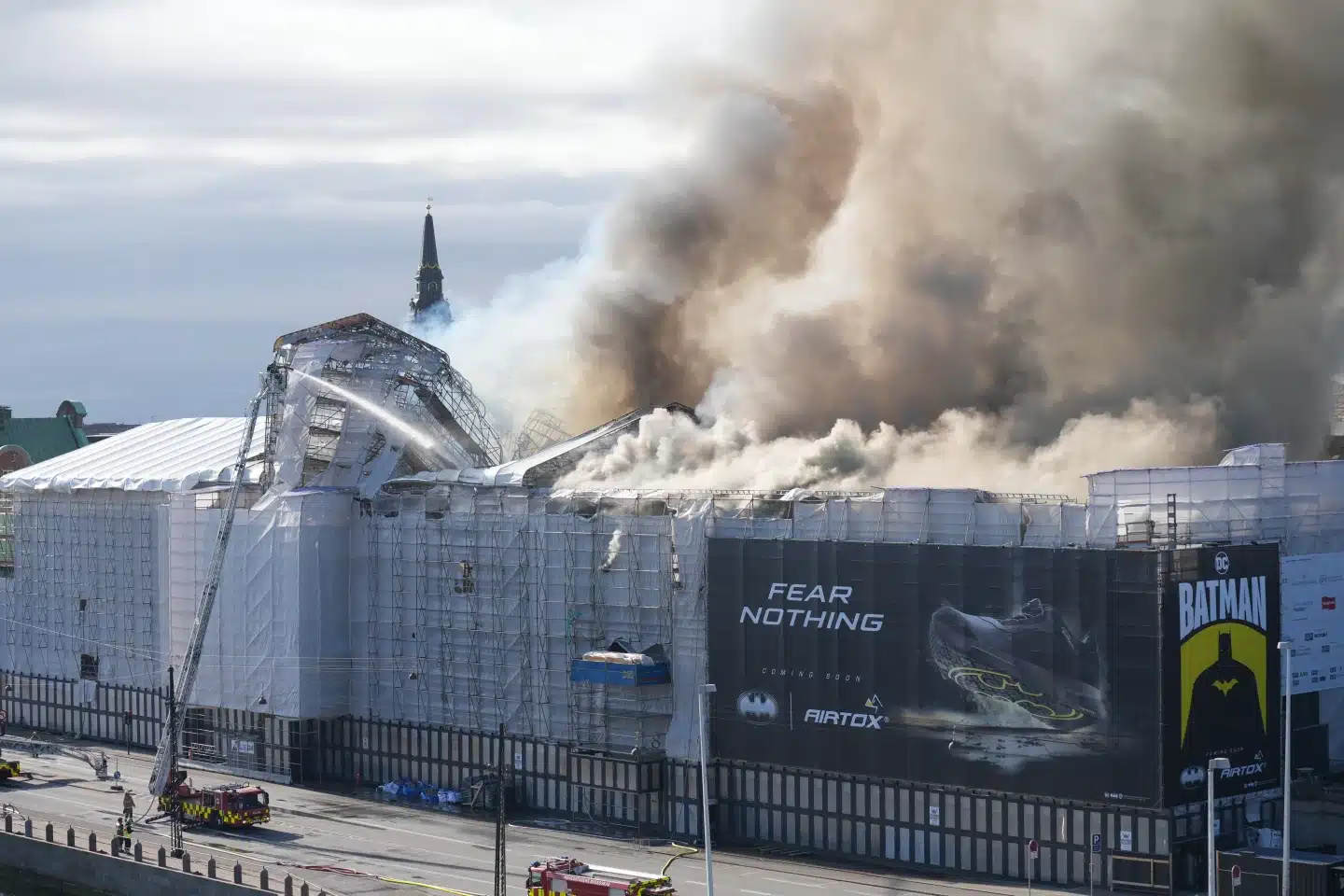News
Fire Destroys Copenhagen’s Old Stock Exchange Dating To 1600s, Collapsing Its Dragon-Tail Spire

COPENHAGEN, Denmark – A fire blazed through one of Copenhagen’s oldest buildings Tuesday, destroying roughly half of the 17th-century Old Stock Exchange and collapsing its famed dragon-tail spire, while bystanders hurried to assist emergency services in saving priceless paintings and other treasures.
During renovations, the blaze started on the building’s roof, but authorities said it was too early to determine the cause. The red-brick structure, with its green copper roof and distinctive 56-meter (184-foot) spire shaped like four interwoven dragon tails, is a prominent tourist attraction in the heart of the capital, near Denmark’s parliament, Christiansborg Palace.
Firemen Extinguish Fire: Image Reuters
Fire Destroys Copenhagen’s Old Stock Exchange Dating To 1600s, Collapsing Its Dragon-Tail Spire
As fire devoured the spire and drove it plummeting down the scaffolding-covered edifice, bells tolled, and sirens screamed. Huge billows of smoke ascended above downtown Copenhagen, visible from southern Sweden, separated from Denmark’s capital by a thin strait.
“A piece of Danish history is on fire,” Prime Minister Mette Frederiksen said on Instagram, lamenting the loss of “irreplaceable cultural heritage.”
There were ambulances on the scene, but no reports of injuries.
Firefighters pumped water from a nearby canal and sprayed it into the doorway of the Old Stock Exchange’s gilded hall, which hosts gala dinners, conferences, and other events and displays many paintings.
Danish Culture Minister Jakob Engel-Schmidt said it was “touching” to see how many people came together “to save art treasures and iconic images from the burning building.” Soon after the fire broke out, one man rushed off his bicycle to aid, while public members assisted first responders in transporting large items of art to safety.
Among the pieces on show in the building was a massive 1895 painting by Danish artist P.S. Krøyer, “From Copenhagen Stock Exchange.” No information has been revealed on which works of art were saved from the blaze, although camera footage shows the Krøyer painting being removed.
Brian Mikkelsen, chief executive of the Danish Chamber of Commerce, which controls the Old Stock Exchange, was spotted with his team going through a binder containing images of artworks that needed to be conserved. Work was done on the adjoining parliament and national archive building. According to Mikkelsen, rescuers used crowbars and other tools to retrieve valuables and save them from the fire.
“We have been able to rescue a lot,” a moved Mikkelsen told reporters. “It is a national disaster.”
According to Jakob Vedsted Andersen, a Greater Copenhagen Fire Department spokeswoman, the fire started on the roof Tuesday morning and swiftly spread, collapsing parts and damaging around half of the building. He said no other structures were in danger, but it could take firemen 24 hours to clear the situation.
Copenhagen’s Old Stock Exchange Gutted: Photo Reuters
Fire Destroys Copenhagen’s Old Stock Exchange Dating To 1600s, Collapsing Its Dragon-Tail Spire
Tim Ole Simonsen, another fire department spokesman, stated, “The fire started in the part of the building where work has been going on, but that’s all I can say about it.”
René Hansen of the coppersmith firm refurbishing the roof informed TV2 that 10 people were on the roof when the fire alarm sounded.
“After five minutes, smoke began to rise from the floor to the ceiling,” Hansen said.
Tommy Laursen of the Copenhagen police said it was too early to determine what started the fire, but officers would be allowed to access the building in “a few days.”
According to Denmark’s armed services, an army squad of up to 90 members was deployed to seal off the area and “secure valuables.”
King Frederik posted on Instagram that “an important part of our architectural heritage” was being destroyed. He also stated in an email that “this morning we woke up to a sad sight.”
The exchange, built in 1615, is a prime example of Dutch Renaissance design in Denmark. After the Copenhagen Stock Exchange left in 1974, the Chamber of Commerce moved into the building.
The roof, brickwork, sandstone, and spire were all being rebuilt, and Mikkelsen stated that the royal family, government leaders, and other dignitaries would be invited to observe the work later this year.
“That won’t happen now,” he stated.
The structure’s future was unknown, but Engel-Schmidt, the cultural minister, stated on the social media site X that he would do everything he could “so that the dragon spire will once again tower over Copenhagen,” describing it as “a symbol of Denmark’s strong history as a trading nation.”
The adjacent Christiansborg Palace has burned down multiple times, and in 1990, a fire broke out in an annex of the Danish parliament known as Proviantgaarden. However, the Old Stock Exchange remained unaffected.
Firemen close area: Photo Reuters
Fire Destroys Copenhagen’s Old Stock Exchange Dating To 1600s, Collapsing Its Dragon-Tail Spire
Police closed a prominent route in Copenhagen and notified the public that the area would be roped off for some time. Several bus routes were redirected, and the Danish media reported massive traffic congestion.
Queen Margrethe, who turned 84 on Tuesday, scaled back her celebrations due to the fire, according to broadcaster TV2. A band from the Royal Life Guard was supposed to perform for the former monarch outside Fredensborg Castle, where she is staying for the spring and summer, but it was canceled.
The Copenhagen fire was similar to the one at Notre Dame in April 2019. The 800-year-old cathedral in Paris also lost its spire. Its rehabilitation is scheduled for completion this year. When Windsor Castle in England caught fire in November 1992, troops and workmen rushed to salvage precious works of art. The fire destroyed the state dining room and other areas of Queen Elizabeth II’s vacation palace.
SOURCE – (AP)
News
Britain Must Be Ready for War in 3 Years, Warns New Army Chief

The new head of the Army has stated that Britain must be prepared to fight a war within three years.
Gen Sir Roland Walker has issued a warning about a variety of risks in what he calls a “increasingly volatile” environment.
However, he stated that war was not inevitable and that the Army had “just enough time” to prepare to prevent conflict.
He stated that the Army’s fighting capacity would be doubled by 2027 and tripled by the end of the decade.
Gen Walker warned that the Britain was under threat from a “axis of upheaval” in his first speech as Prime Minister on Tuesday.
Among the primary concerns confronting the Britain in the next years, as noted by the general in a briefing, is an enraged Russia, which may seek vengeance on the West for helping Ukraine, regardless of who wins the war.
He stated: “It doesn’t matter how it finishes. I believe Russia will emerge from it weaker objectively – or completely – but still very, very dangerous and seeking some form of retaliation for what we have done to assist Ukraine.”
Britain’s Government Defence Review and Military Challenges
He also warned that China was determined to retake Taiwan, and Iran was likely to seek nuclear weapons.
He stated that the threats they posed may become particularly acute in the next three years, and that these countries had formed a “mutual transactional relationship” since the war in Ukraine, sharing weaponry and technology.
However, he stated that the path to conflict was not “inexorable” if the UK re-established credible land troops to assist its deterrent strategy for avoiding war.
In his speech, he described his force of slightly over 70,000 regular troops as a “medium-sized army” and made no direct call for additional resources or men.
However, he pushed the British Army to adapt swiftly, focussing on technology such as artificial intelligence and weaponry rather than numbers.
His ultimate goal is for the Army to be capable of destroying an opponent three times its size.
This would entail firing quicker and farther, he said, aided by lessons learnt from the Ukraine war.
The general’s speech at the Royal United Services Institute land warfare conference comes only one week after the government began a “root and branch” defence review to “take a fresh look” at the challenges facing the armed services.
Defence Secretary John Healey launched the assessment, describing the existing status of the armed forces as “hollowed-out” and stating that “procurement waste and neglected morale cannot continue”.
According to the most recent Ministry of Defence (MoD) numbers from April 2024, the Britain’s regular Army forces total 75,325 troops (excluding Gurkhas and volunteers).
That figure has been declining in recent years, as recruiting has failed to match retention. The previous Conservative administration lowered the planned headcount from 82,000 to 72,500 by 2025.
Members of the NATO military alliance have agreed to spend at least 2% of GDP on defence by 2024, but several countries are unlikely to fulfil this goal.
The Britain presently spends 2.3% of its GDP on defence. Prime Minister Sir Keir Starmer has previously stated that the defence review will include a “roadmap” for increasing this to 2.5%, however he has yet to provide a date for this promise.
Source: BBC
News
Katie Ledecky Hopes For Clean Races At Paris Olympics In The Aftermath Of The Chinese Doping Scandal

PARIS — Katie Ledecky is looking for clean Olympic races. On Wednesday, Hope had pretty much reached her limit.
The American swimmer hopes to add to her six gold medals as she competes in the 400, 800, and 1,500 meters at the Paris Games. Her program starts with the heavy 400 on Saturday, featuring Ariarne Titmus and Summer McIntosh.

Katie Ledecky | ESPN Image
Katie Ledecky Hopes For Clean Races At Paris Olympics In The Aftermath Of The Chinese Doping Scandal
The 27-year-old Katie is competing in her fourth Summer Olympics, but the first since a doping scandal involving almost two dozen Chinese swimmers who tested positive for a banned chemical before the Tokyo Games — yet were permitted to compete with no consequences. The controversy has raised serious worries regarding the effectiveness of anti-doping initiatives.

Katie Ledecky | Vogue Image
“I hope everyone here is going to be competing clean this week,” Ledecky claimed. “But what truly counts is, were they training cleanly? Hopefully this has been the case. Hopefully, there has been worldwide testing.”
The International Olympic Committee has expressed concern over the ongoing US investigation into possible doping by Chinese swimmers. While awarding the 2034 Winter Olympics to Salt Lake City on Wednesday, the IOC urged Utah officials to do whatever they could to stop the FBI investigation.
“I think everyone’s heard what the athletes think,” Katie added. “They seek transparency. They want more answers to the remaining questions. At this point, we are here to race. We are going to race whoever is in the lane next to us.
“We are not paid to conduct the tests, so we trust those who follow their regulations. That applies both today and in the future.

Katie Ledecky | ESPN Image
Katie Ledecky Hopes For Clean Races At Paris Olympics In The Aftermath Of The Chinese Doping Scandal
SOURCE | AP
News
London Heatwave Alert: High Temperatures Set to Soar to 29C Next Week

As the summer holidays begin, London may experience an official heatwave with temperatures reaching up to 29 degrees Celsius.
The Met Office predicts a long period of sunny and dry weather for London after a soggy spring and summer.
After a cloudy day on Saturday, temperatures are expected to reach 27C on Sunday, with lots of sunlight.
On Monday and Tuesday, temperatures are forecast to peak at 29 degrees Celsius. Monday is forecast to offer more sunlight, while Tuesday may see some gloomy weather.
Temperatures are expected to remain in the high 20s next week, with lows of approximately 18C.
According to the Met Office, a heatwave is “an extended period of hot weather relative to the expected conditions of the area at that time of year, which may be accompanied by high humidity.”
In the United Kingdom, a heatwave is proclaimed when daily temperatures meet or surpass a certain level for at least three consecutive days.
In London, the heatwave threshold is 28 degrees Celsius.
The Met Office reported that the UK is experiencing hotter and wetter weather on average due to climate change.
The UK experienced its warmest May and April on record this year, despite damp and dismal conditions in many areas.
According to the Met Office’s State Of The UK Climate 2023 report published on Thursday, the UK experienced historic levels of extreme weather last year.
In the United Kingdom, 2023 was the second warmest year on record, bringing storms, flooding, strong heatwaves, and rising sea levels; only 2022 was warmer.
It was 0.8°C higher than the average from 1991 to 2020, and 1.66°C higher than the 1961 to 1990 average.
However, 2023 will be a “cool year” in comparison to 2100, based on the planet’s warming trajectory.
The government’s plan to adapt to the hazards presented by climate change is currently being challenged in the High Court by campaigners who allege the Tory administration’s July 2023 National Adaptation Programme (NAP) fails to adequately address 61 concerns.
Source: The Standard
-
World2 weeks ago
Former President Trump Survives Being Shot at Pennsylvania Rally
-
Tech4 weeks ago
Huawei Launches 5G-A Pioneers Program at MWC Shanghai 2024: Paving the Way for a Connected Future
-
Sports4 weeks ago
NBA Draft: Kyle Filipowski Withdraws Unexpectedly From The First Round
-
Tech4 weeks ago
ChatGPT Answers Undiscovered Questions and Outperforms Students.
-
News4 weeks ago
US Supreme Court Rejects Drug Deal that Protects the Sackler Family
-
Health4 weeks ago
US Health Agency Issues Dengue Virus Infection Warning


















